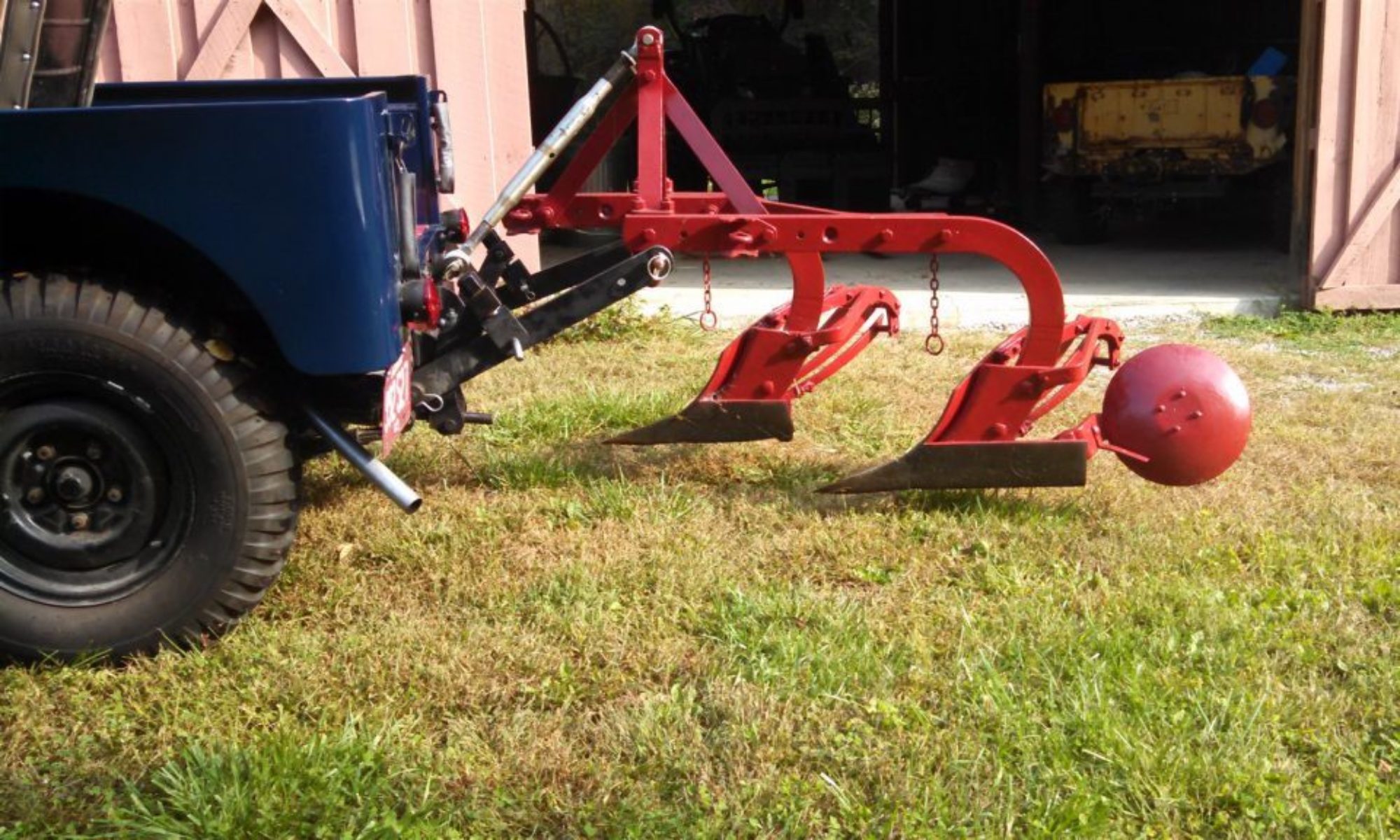The story of the Farm Jeep stretches across two decades, beginning with the introduction of the CJ2a in 1945 and ending, at least unofficially, when the CJ5 gas tank was moved from under the driver’s seat to between the rear frame rails around 1970. As defined for this series, a “Farm Jeep” was any post- WWII Jeep equipped with parts needed to perform the functions of a tractor. The first four articles have focused on the “Jeep Approved” hydraulic lifts; the Love/Newgren Lift and Monroe lift. This last installment will cover the years following the introduction of the Monroe lift, and the fourth “Jeep Approved” lift produced by the Stratton Equipment Company.
The “Official” Farm Jeep
While the major engineering surrounding the “approved” lifts took place in the years between 1945 and 1948 little else changed in the technology that made the Jeep a tractor. Early ads showed the Jeep as a true farm tool, with equal emphasis on towing, hauling, stationary power and tractor work. The introduction in 1951 of the “Farm Jeep” and the “Jeep Tractor” models marked a change at Willys.[1] Willys formed a special department to address slumping sales and the result was an ad campaign to make it clear that the Jeep was a serious farm tractor. How the “Jeep Tractor” was ever a good idea is hard to understand. From the very beginning, what made the Jeep special, and different from every other tractor, was its ability to move quickly from field to town all year long in any kind of weather. The “Jeep Tractor” was just that, a nothing special tractor.
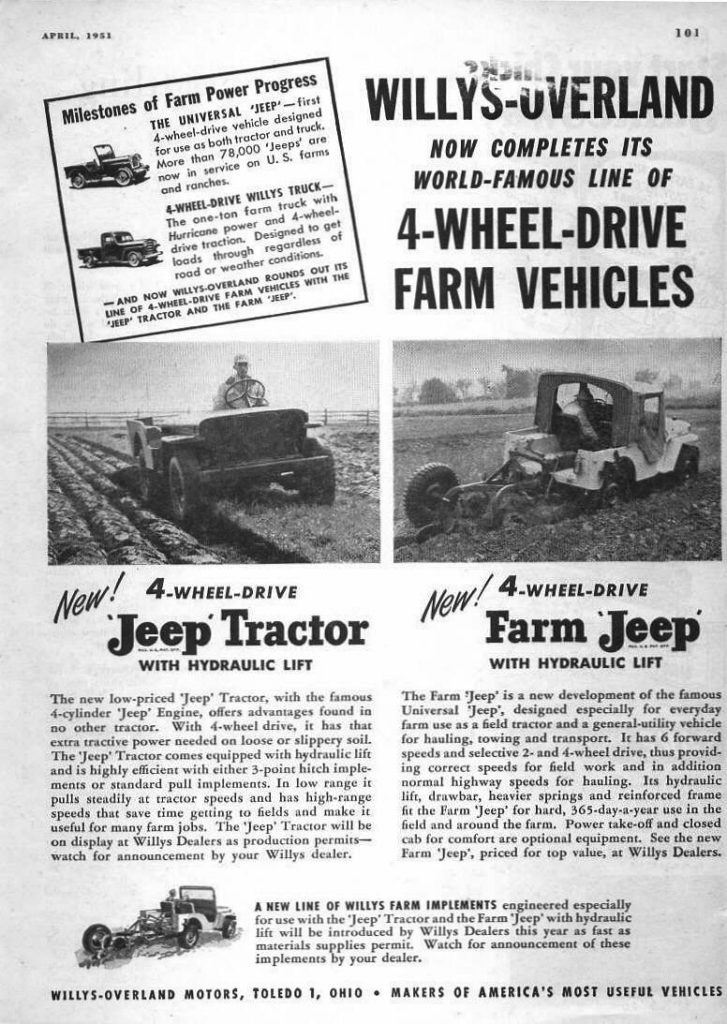
The “Jeep Tractor” was a very stripped down CJ3a, so there wouldn’t have been any production investments required. Yet someone felt having a “Jeep Tractor” was an important marketing tool, even though it was the antithesis of the “Universal” vehicle. Perhaps it was a case of the public just not “getting” the idea of a Jeep as a tractor.
The author has displayed his 1949 CJ3a with a Newgren Lift at numerous antique tractor shows. It wasn’t until he mounted a plow on the back that visitors could “get” the concept of the Jeep as a farm tractor. The very low production numbers in may well be a clue to Willys’ intent.[2] They wanted the Jeep to be known as a “real” tractor but didn’t plan on a large sales volume of the model. They did plan on and required the “Farm Jeep” to be a major player in agricultural marketplace. The marketplace faced by Willys in 1951 was changing rapidly.
The Marketplace
A common question heard is “Why weren’t more Farm Jeeps sold?” Part of the answer may be found in the timing of Farm Jeep’s introduction and in a brief review of agricultural history. The first “agricultural revolution” occurred in the 19th century with the invention of a number of horse-drawn implements. The second revolution occurred in mid-twentieth century with the replacement of draft animals with tractors. [3] The Farm Jeep (here we return to broader definition) was a part of the trend that saw the number of tractors exceed the number of horses and mules used for farming in 1945.[4]
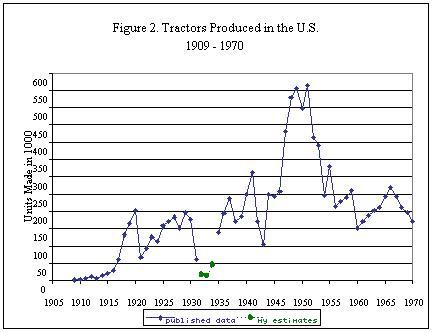
According to an article by the Economic History Association, tractor production reached 564,000 units in 1951.[5] While the Ford 9N/8N, as discussed in prior articles, was the primary competition, a farmer in 1951 could choose among dozens of tractors. The big tractor producers (Deere, Ford, Massey-Ferguson, Case, Allis Chalmers, Oliver and Minneapolis Moline) held 98.8% of market share in the period of 1950-55.[6] Willys would need to fight for even that 0.2% share against several other small, specialty tractor producers.
The tractor and associated technologies radically changed farming in the 20th century. In 1900 40% of the US workforce was involved in agriculture.[7] By 2000/2002, that number had fallen to just 1.9%. Willys’ first target was the farmer with 40 acres and a couple of mules, still a significant market in 1945. But with the improvements in tractors and equipment, the average farm acreage grew, and the number of farms declined. In 1940, the average farm was 175 acres, by 1950 had increased to 216 acres and by 1960 was 303 acres.[8] Farmers wanted and purchased larger tractors and specialized harvesting equipment to allow them to keep up with the growing farm. The Farm Jeep remained focused on the dwindling family farm. It was the same 2-bottom plow tractor in 1956 and indeed in 1965 as it was in 1946. The tractor marketplace was not the same.
The Second Decade
One measure of the importance to Willys of the agricultural market can be found in the number of farm-related items listed in the Jeep Optional Equipment catalogs provided to dealers. These books, which appear to have been printed yearly, contain add-on equipment that had been “tested and approved” by Jeep engineers. Individual books are rare, but reproduction copies covering multiple years are readily available. They make for fun browsing but can also provide some insight to the changes occurring in the tractor and related products industries.
The reproduction book covering 1946-49 contains over 60 products including about every farm implement available at the time and, of course, the Monroe lift. The book is divided into agricultural implements and industrial equipment. The 1957-59 books contain only a dozen or so farm implements in addition to the Monroe lift. The farm equipment producers had changed with the market and were now selling equipment for larger tractors and the large variety of implements for a 2-bottom plow tractor seen in 1946-49 were no longer available.
Up until 1954, ads for the Universal Jeeps had shown them as the only vehicle needed for the farm. The Jeep could handle all the jobs: transportation, hauling, stationary power and field work. At the beginning of the second decade of the Farm Jeep, ads began to change, reflecting the new realities of farming.
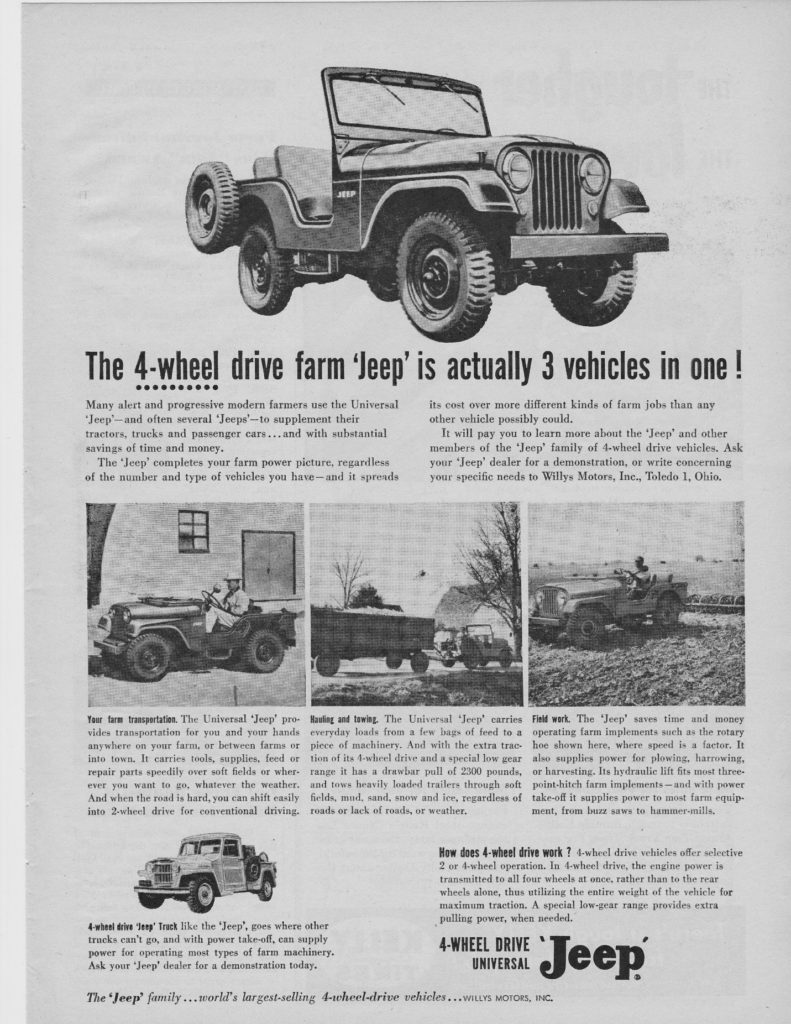
An ad from 1955, states “Many alert and modern farmers use the Universal ‘Jeep’- and often several ‘Jeeps’-to supplement their trucks, tractors and passenger cars…and with substantial savings of time and money.” Other ads from 1954, talk of how one farmer uses the Jeep on his farm of 1,000 cultivated acres and how another farmer uses his Jeep to manage three separate farm operations. Willys had come to realize that the family farm of 1945 had changed drastically in the decade following World War II.
The Stratton Lift – Too Little, Too Late?
The 1960-62 equipment book contains only a few implements but does replace the Monroe lift with the Stratton Equipment Company Hydro-Implement Lift. This will be last “Jeep Approved” lift and marks the final development in the Farm Jeep story. It is unclear when the Stratton Lift first became available. The patent application was filed in July 1960 and awarded in February 1963.[9] The exacts date when the Monroe Lift was no longer available and when the Stratton Lift first appeared remains a mystery for now. Further research should be done. Since the best guess is that production of the Monroe Lift stopped around 1956, it seems likely that Willys would have sought a replacement before 1960. Who was this Stratton Equipment Company?
Ronald Stratton started two business in Cleveland after WWII.[10] One was a car dealership and the other a company that produced hydraulic load lifting and material handling equipment. The Stratton Equipment Company produced refuse handling equipment (garbage trucks) and other hydraulic-related equipment, such as tailgate lifts. until the mid-1960s. In 1956, according to a newspaper clipping found in a file at the Cleveland Public Library, Stratton announced he was selling his car business to concentrate on the hydraulic business. He was expecting big things to happen.
One thing that did happen about then was the appearance of Stratton hydraulic tailgate lifts for the Willys pickup and new FC truck line. Around this same 1956-timeframe, Monroe was stopping production of its Monroe Lift. As stated above, it seems likely that Willys would have been looking for a replacement product. Did Willys approach this new supplier with the idea of developing an implement lift or did Stratton approach Willys?
While the true facts may never be known, it is fun to speculate. Given what little information is available, it would seem more likely that Willys approached Stratton. First, based on patent filings and product offerings, at no point in Stratton’s history was there ever a product aimed at the agricultural market. Alford F. Foote is listed as the inventor of the Jeep lift. Searches of his other patent filings failed to produce anything like the Jeep lift.
Second, the verbiage of the patent application appears to have been written by someone at Willys or someone with intimate knowledge of past Farm Jeep lifts.[11] The patent description specifies,
“This invention relates to lifting devices for implements, and more particularly to a hydraulic lift adapted to be attached to an automotive vehicle for the purpose of connecting, raising, or lowering implements which are operable by the vehicle.
Although the invention may be advantageously employed on various types of automotive vehicles, for convenience it will be discussed and illustrated as used on a lightweight utility type automotive vehicle of the type sold under the trademark “Jeep” having at the rear of its body an open-topped cargo-carrying portion, preferably equipped with an end gate and with a power takeoff mechanism located at the rear of the vehicle below the floor of the body.
For most effective use of both the lift and the vehicle to which the lift is attached, the lift should satisfy several conditions. It should be capable of easy installation on the automotive vehicle with little or no change to the vehicle. After installation, it should not interfere with the normal usage of the vehicle for cargo carrying and should not impair the road clearance of the vehicle; it should not prevent access to or impede operation of the power takeoff, so that the power takeoff can be used for operation of implements attached to the lift or for other purposes not related to the lift. The lift arms should be readily removably, without requiring removal of the remainder of the lift mechanism, when the vehicle is to be used for purposes in which the projecting arms might be undesirable.,,”
“Prior lifts for such vehicles fail to provide many of these features. Most commonly, their design is such that the lift actuating mechanism occupies a considerable amount of space in, or otherwise obstructs, the cargo carrying portion of the vehicle, and usually prevents use of the end gate…”
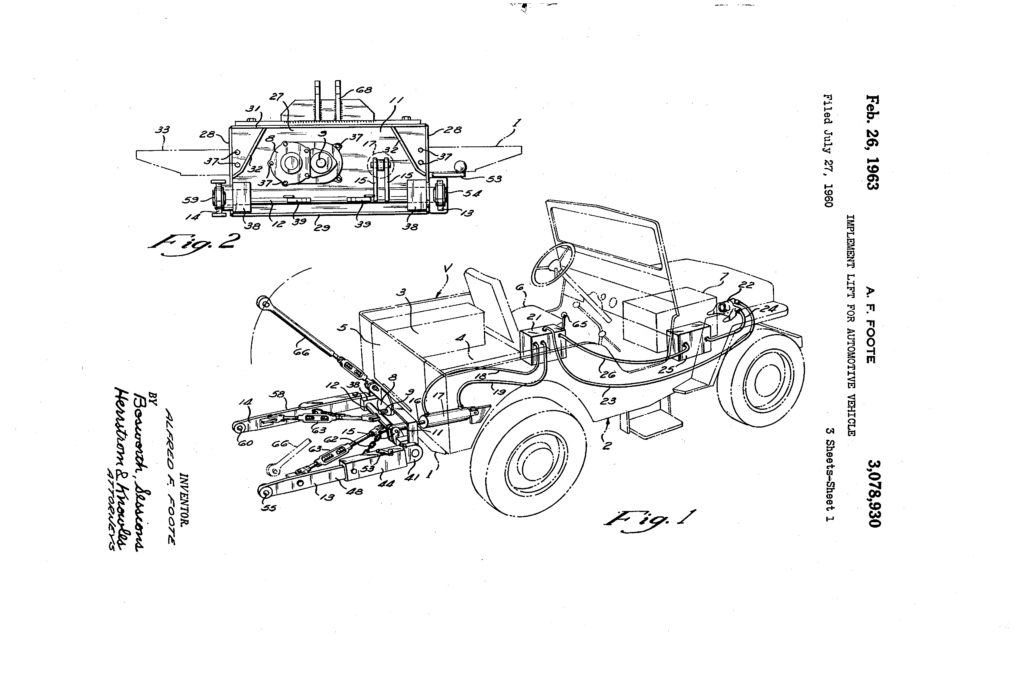
Some of this verbiage was necessary to get around the Ford/Ferguson patents that were specially aimed at “tractors.” But the description of the shortcomings of the Monroe Lift – taking up cargo space and not being easily removable – would seem to have come from Willys. The description also raises the question about the Monroe Lift’s impact on the Farm Jeep’s success. Did the placement of the Monroe Lift in the cargo bed result in a less functional and therefore less desirable vehicle?
Finally, there is the appearance at Willys of Ivan Schatazka, a former test engineer at Monroe Auto Equipment Co who had worked extensively on the Monroe lift.[12] In an earlier article by this author speculated that Charles Sorenson, a former Ford executive, had been instrumental in getting J. B. Love to develop the first hydraulic lift for Willys.[13] Did Schatazka play the Sorenson role and sell the idea to Stratton? The answer may be out there, but for now, one must be satisfied that the Stratton lift did get built and was a major improvement over all prior “approved” lifts.
The Stratton Lift, like the Newgren Lift, left the bed free for cargo (or passengers) and the lift arms could be quickly removed when not needed. It also corrected, as the Monroe lift had, the plow geometry issue caused by the lowered top link (the third attachment point of a 3-point hitch). The Farm Jeep was finally back to its intended “Universal” vehicle configuration. But it seems that it was too late.
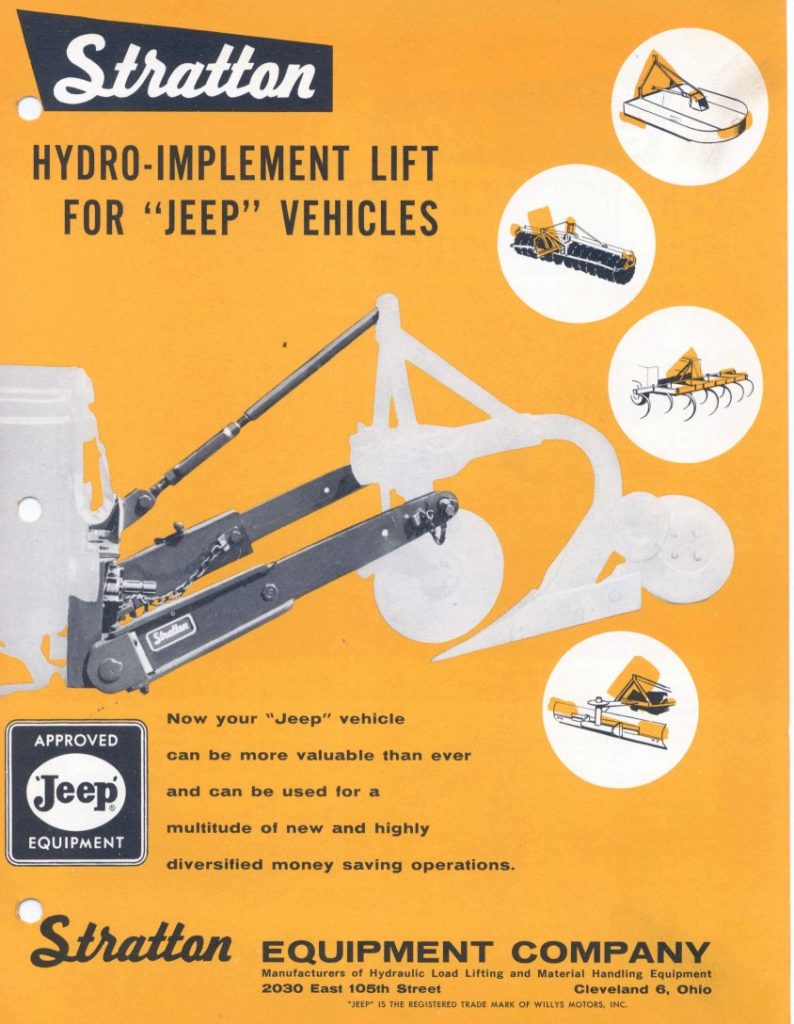
What happened to the Farm Jeep next remains a mystery. Stratton sells his company in 1965, and the buyers of the company seemed to have absorbed the assets, but no information is available on what became of the Jeep lift production. The final nail in the Farm Jeep’s demise was the decision to move the gas tank from under the driver’s seat of the CJ5 to a more conventional location. That move meant that the PTO and under-bed 3-point hitch were no longer an option.
A Quiet End
After the mid-1960s, the Farm Jeep just seems to disappear as an entity. Was it the changing marketplace, the small family farm had all but disappeared, or was the lack of suitable equipment, with no 3-point hitch available, that ended the long run? Or was it a change in product strategy that came with new ownership and management? At the mid-point of the Farm Jeep existence, Willys seems to have cut back on the direct-to-farmer advertising. At least there are fewer examples to be found from 1955 forward. By the late 1960s, even before AMC was in full control, ads made it clear that Jeeps were for fun and maybe a little farm work, but certainly not meant to be a tractor. There are ads from the 1970s and 1980s showing Jeeps being used on farms and ranches, pulling trailers and involved in other chores, but no field work. Like an old soldier, the Farm Jeep didn’t die, it just faded away.
………
Notes from the author-
In the first part of the series, Clint Dixon is referred to as a “Monroe Automobile Equipment Company” historian. That should have been the “Monroe Auto Equipment Company.” My apologies for that error.
In the second article in the series, the statement was made that it was not known who manufactured the Newgren lift. It was gently pointed out by a reader that the lift installation instructions posted at www.farmjeep.com clearly states the lifts were manufactured by “Benedict Manufacturing Co. (Serial No Prefix BL)”.
[1] Bob Westerman, Willys Farm Jeep and Farm Tractor, http://www.cj3a.info/cj3a/farmjeep/fj.html
[2] Ibid.
[3] History of American Agriculture – https://www.thoughtco.com/history-of-american-agriculture-farm-machinery-4074385.
[4] Economic History of Tractors in the United States – https://eh.net/encyclopedia/economic-history-of-tractors-in-the-united-states/
[5] Ibid.
[6] Ibid.
[7] USDA 20th Century Transformation of US Agriculture and Farm Policy – https://ageconsearch.umn.edu/bitstream/59390/2/eib3.pdf.
[8] History of American Agriculture. – https://www.thoughtco.com/history-of-american-agriculture-farm-machinery-4074385
[9] Stratton Lift Patent 3,078,930
[10] Ronald Stratton obituary – https://www.findagrave.com/memorial/126198042/ronald-robert-stratton
[11] Stratton Lift Patent 3,078,930
[12] Clint Dixon, The Making of the Farm Jeep – Part 3, Dispatcher, Spring 2018, page 24
[13] The Making of the Farm Jeep – Part 1, Dispatcher, Fall 2017, page 10
